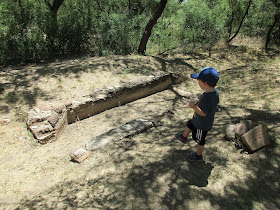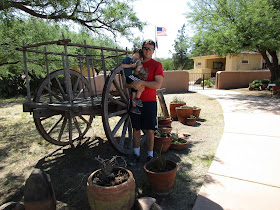Hiking and exploring the remote areas of the west with an emphasis on Arizona. Prior to July of 2013 emphasis on Nevada and Utah.
Friday, June 2, 2017
Ruby, Arizona March 2017
Out of all the ghost towns in Southern Arizona Ruby is one of the best preserved for a number of reasons. First, for many years the town remnants were on private land and visitors could not walk around. Second, there is a caretaker who oversees the grounds and charges visitors. As a result, there are dozens of standing buildings, ruins and two lakes Town Lake and Eagle Lake created mine tailings. One is contaminated from mining while the other one is pristine and visitors can swim in it during the summer. Even with the entrance fee I would recommend Ruby to any ghost town enthusiast. Ruby was an underground mining operation with mine shafts extending down 700 feet. Many of the hills surrounding Ruby are unsafe for walking. Please stay on designated paths.
History: The area around Ruby was first mined in 1870. After the first strike a small community formed called Montezuma Camp. Ore deposits showed lead, silver, gold, zinc and copper. Julius Andrews, store owner and post master, named town after wife Lillie Ruby Andrews. The most prosperous period for Ruby began in 1926 when the Eagle-Picher Lead Company overtook operations. In 1926 Ruby had electricity, doctor, hospital and school. From 1934-1937 the Montana Mine was leading producer of lead and zinc in Arizona. In 1936 the mine was third in silver production.
Ruby had a reputation for lawlessness and a couple of murders highlight its violent past. Because the town is close to Mexico it had problems with raids and bandits. Philip C Clark who ran the general store in 1913 commented that he kept firearms in every room of house. Clark also spread a tall tale that a pipe in front of his store fired poison gas from a switch in the building. Supposedly the tale kept revolutionary soldiers from robbing the store. Subsequent owners did not heed Clark's advice about safety and paid the price. In 1920 John and Alex Frasier bought the store. Within a couple of months Alex was shot dead and John shot in eye by two bandits. In 1921 Frank Phearson bought store. August 1921 Frank and wife were killed by armed men. Incredibly their young daughter was spared.
(Info from: Arizona Ghost Towns and Mining Camps bu Philip Varney)
Rub has worked with many groups including Arizona Game and Fish and US Fish and Wildlife Service to protect it wildlife. A big-game fence was constructed around the property to keep cattle out. A colony of Mexican free tail bats numbering around 150,000 live in Ruby's shafts from May to September. There have also been sightings of a Jaguar and unconfirmed reports of a Mexican wolf being heard as well. (Info from Ruby information sheet)
.
Tumacacori National Historic Park May 2016 and March 2017
The church at Tumacacori
Tumacacori National Historic Park is my favorite day trip from Tucson. It is about 55 miles south of Tucson on Interstate 19. The grounds preserve in a state of decay one of the missions Father Padre Eusebio Kino established in Southern Arizona. The park service has done a good job with interpretive signing. There is also a guided tour as well as events throughout the year. Visitors can also walk down to the Santa Cruz River and hike along the Anza Trail to the town of Tubac. The Santa Cruz is running in this section because of reclaimed water do not wade or swim. All National Parks, Monuments and State Parks have junior ranger programs to engage the youth.
History: Padre Eusebio Kino established Tumacacori in January of 1691. The first missionaries who lived at Tumacacori were of the Company of Jesus (Jesuits). They maintained Tumacacori as well as two satellite missions: Guevavi and Calabazas. From 1768 to 1848 Fransiscan missionaries managed Tumacacori. In 1848 Padre Liberos was expelled by the Mexican Government after Mexico won its independence from Spain. Afterwards the missions fell into a state of disrepair. As stated before Tumacacori is managed in a state of arrested decay. Guevavi and Calabazas have very little remaining. The park service gives tours of Guevavi and Calabazas during certain months of the year. Today preservationists are replacing many of the old adobe blocks in order to keep the structures standing. (Info from: www. nps.gov/tuma/learn/historyculture/tumacocori).
Inside the church
Church graveyard
On Tumacacori's grounds
Quintin exploring
Santa Cruz River
The Anza Trail
Tumacacori National Historic Park is my favorite day trip from Tucson. It is about 55 miles south of Tucson on Interstate 19. The grounds preserve in a state of decay one of the missions Father Padre Eusebio Kino established in Southern Arizona. The park service has done a good job with interpretive signing. There is also a guided tour as well as events throughout the year. Visitors can also walk down to the Santa Cruz River and hike along the Anza Trail to the town of Tubac. The Santa Cruz is running in this section because of reclaimed water do not wade or swim. All National Parks, Monuments and State Parks have junior ranger programs to engage the youth.
History: Padre Eusebio Kino established Tumacacori in January of 1691. The first missionaries who lived at Tumacacori were of the Company of Jesus (Jesuits). They maintained Tumacacori as well as two satellite missions: Guevavi and Calabazas. From 1768 to 1848 Fransiscan missionaries managed Tumacacori. In 1848 Padre Liberos was expelled by the Mexican Government after Mexico won its independence from Spain. Afterwards the missions fell into a state of disrepair. As stated before Tumacacori is managed in a state of arrested decay. Guevavi and Calabazas have very little remaining. The park service gives tours of Guevavi and Calabazas during certain months of the year. Today preservationists are replacing many of the old adobe blocks in order to keep the structures standing. (Info from: www. nps.gov/tuma/learn/historyculture/tumacocori).
Inside the church
Church graveyard
On Tumacacori's grounds
Quintin exploring
Santa Cruz River
The Anza Trail
Tubac Presidio State Historic Park May 2016
Quintin in front of the museum
The Presidio and town of Tubac is nice day trip Tucson. It is approximately 51 miles south of Tucson Interstate 19. The town of Tubac, Arizona, has become an art mecca with art galleries and festivals throughout the year. There is also a thriving retirement community with older Americans moving to Tubac and nearby Green Valley because of the weather and amenities. In May of last year I visited Tubac Presidio State Historic Park with my son Quintin. The Presidio was Arizona's first State Park and it is the only surviving Spanish Presidio in Arizona.
The Spanish established San Ignacio de Tubac in 1752 in response to the Pima Indian Rebellion. Its mission was to protect the various missions in the area and quell Native American uprisings. The most famous commander of the Presidio was Juan Bautista de Anza II. He led an expedition to California on what is now the Anza trail where he founded the city of San Fransisco. Visitors can hike four miles of this trail south to Tumacocori.
A visit to the Presidio is very interesting. Visitors can tour the museum on site which gives a comprehensive history of the Spanish in Arizona, look at some of the remaining buildings at the Presidio and go into the oldest territorial schoolhouse in Arizona. A highlight of the museum is the hand press which printed the first newspaper in Arizona. (Info from http://azstateparks.com/tubac/.
"Ruins of Tubac" inside the museum
Interesting barbed wire
The printing press
Quintin and I in front of an old wagon on museum grounds
The Presidio and town of Tubac is nice day trip Tucson. It is approximately 51 miles south of Tucson Interstate 19. The town of Tubac, Arizona, has become an art mecca with art galleries and festivals throughout the year. There is also a thriving retirement community with older Americans moving to Tubac and nearby Green Valley because of the weather and amenities. In May of last year I visited Tubac Presidio State Historic Park with my son Quintin. The Presidio was Arizona's first State Park and it is the only surviving Spanish Presidio in Arizona.
The Spanish established San Ignacio de Tubac in 1752 in response to the Pima Indian Rebellion. Its mission was to protect the various missions in the area and quell Native American uprisings. The most famous commander of the Presidio was Juan Bautista de Anza II. He led an expedition to California on what is now the Anza trail where he founded the city of San Fransisco. Visitors can hike four miles of this trail south to Tumacocori.
A visit to the Presidio is very interesting. Visitors can tour the museum on site which gives a comprehensive history of the Spanish in Arizona, look at some of the remaining buildings at the Presidio and go into the oldest territorial schoolhouse in Arizona. A highlight of the museum is the hand press which printed the first newspaper in Arizona. (Info from http://azstateparks.com/tubac/.
"Ruins of Tubac" inside the museum
Interesting barbed wire
The printing press
Quintin and I in front of an old wagon on museum grounds





















